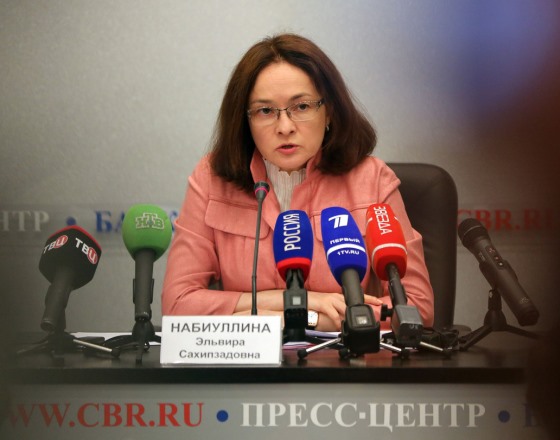
Russia’s central bank is tethering the ruble again, seven months after allowing it to trade freely, according to more than a third of the economists surveyed by Bloomberg.
Eleven of 28 analysts said the central bank is anchoring the Russian currency and their median estimate for policy makers’ goal was 55 against the dollar, according to the June 22-25 survey. The rest said the bank has no specific exchange rate in mind. The ruble isn’t currently in free float, according to 45 percent of respondents. The currency, which touched 80 to the dollar on Dec. 16 and was as strong as 48.8290 on May 13, has averaged 54.4 in June.
Doubts about the Bank of Russia’s commitment to its free float are sprouting after policy makers resumed foreign-currency purchases to replenish reserves as the ruble’s world-beating rally crimped export revenue already decimated by lower oil prices. The ruble has lost more than 10 percent since the interventions began in mid-May, winningpraise from President Vladimir Putin for a weak-currency policy as a crutch for domestic producers.
“The exchange rate still matters for the central bank,” said Wolf-Fabian Hungerland, an economist at Berenberg Bank in Hamburg, Germany. “While flexible exchange rates generally cushion shocks to the macro-economy, increased volatility or exaggerated currency movements can quickly feed back negatively.”
Ruble Steadies
The ruble’s three-month implied volatility, a measure of exchange-rate swings, is at 20 percent, the highest globally, according to data compiled by Bloomberg. It dropped 1.3 percent against the dollar on Monday as concern Greece will leave the euro region pared this year’s advance to 9.4 percent. The ruble depreciated 46 percent in 2014.
The currency’s rate at around 54 against the dollar is “ideal” for encouraging Russia to embark on structural reforms, Finance Minister Anton Siluanov said on June 20. Among the economists who said the central bank is steering the Russian currency, estimates of the exchange rate sought by policy makers ranged from 50 to 60 against the dollar.
The ruble has stabilized since late May, trading stronger than its 50-day average versus the dollar and weaker than its 100-day moving average. Breaching moving averages signal to some traders a move has momentum to continue.
Rebuilding Reserves
The Bank of Russia is buying as much as $200 million daily to boost reserves to $500 billion, a process it estimates may take from five to seven years. Replenishing the stockpile doesn’t contradict the central bank’s consumer-price growth target of 4 percent in the medium term, according to Governor Elvira Nabiullina.
“The operations are not aiming to support the ruble’s exchange rate at a specific level,” Nabiullina said June 15.
The central bank’s presence on the currency market doesn’t mean it’s abandoning the free float, according to Vladimir Miklashevsky, a strategist at Danske Bank A/S in Helsinki.
“Despite the Russian central bank’s interventions to replenish FX reserves, we see the ruble as freely floating at the moment,” he said. “The central bank’s and the government’s only concern is the ruble’s extreme strength given the current oil price.”
The central bank’s shift has been met with criticism from Economy Minister Alexei Ulyukayev, a former first deputy central bank governor who handled monetary policy and was a candidate to take over the Bank of Russia two years ago. The bank’s goal on rebuilding reserves, alongside its commitment to inflation targeting, may be confusingto investors, Ulyukayev told Moscow-based newspaper Kommersant in an interview published last Thursday.
“I think we can call it a slightly tarnished float,” said Tatiana Orlova, the chief Russia economist in London for Royal Bank of Scotland Group Plc. The central bank’s currency purchases show “that it’s not a pure float. However, I would not call the FX regime a managed float either, as normally this classification presumes a heavier degree of FX rate management.”
original source: http://www.bloomberg.com/news/articles/2015-06-28/russia-free-float-skeptics-gather-as-ruble-seen-on-shorter-leash
